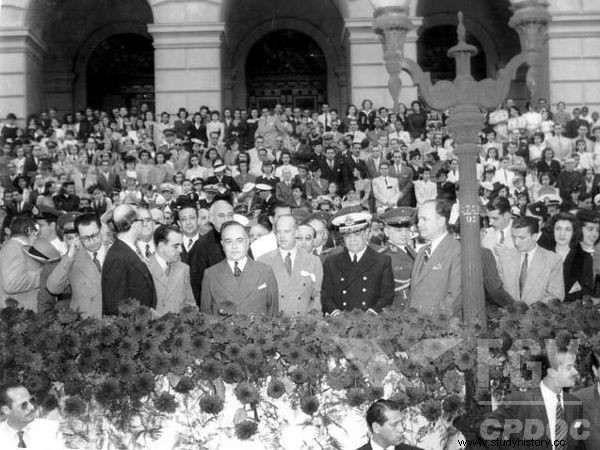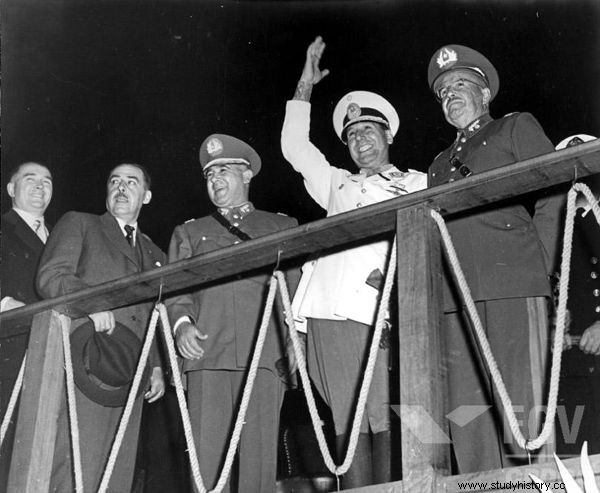
The definition of populism is quite complex, but generally speaking, when the term is used, it refers to practices policies exercised by governments from America Lat ina, throughout the twentieth century. In the case of Brazil, the classic concept of populism is closely associated with the period from 1930 to 1964, considered the heyday of populism in Brazil.
Still, the definition of populism dragged on. for the 21st century and is closely related to governments that have a great appeal with the poorest strata of the place they govern. In Brazil, some of the presidents who were considered symbols of populism were Getúlio Vargas, Juscelino Kubitschek and João Goulart.
Also see: Learn a little about the history of elections in Brazil
Characteristics of Populism
The basic concept of populism can be structured according to the characteristics listed by Professor Marcos Napolitano|1| .
-
Leader's direct and non-institutionalized relationship with the masses :in this characteristic, we perceive that the populist leader creates his relationship with the masses in a direct way and based on his charisma. Furthermore, the construction of this relationship with the people takes place without the existence of a political structure that validates it.
-
Economic Nationalism :populist regimes generally assume positions with a nationalist bias when it comes to the economy.
-
Speech in defense of mass union :the populist leader's speech always turns to the conciliation of classes, since his speech goes to the nation. There are also populist leaders who emphasize a speech on behalf of the “people”, against an elite or a tyrannical oligarchy.
-
Political leadership based on patronage :in addition to charisma and speeches, which appeal in the name of the nation or the people, the populist leader supports his power in the network of exchange of favors, also known as clientelism.
-
Fragile party system :the classic concept of populism presupposes the existence of a party system either in an embryonic stage, or inexistent, or dismantled by the populist leader. This reinforces the idea that the power of the populist leader is not based on the political system, but on his charisma.
This characterization of populism, as mentioned, is related to the history of Brazil in the period 1930-1964 and has in its great representative Getúlio Vargas, especially during the Estado Novo. In the case of Latin America, populism is used to explain the historical experiences related to Peronism (Argentina), aprismo (Peru) and Cardenismo (Mexico).
Other scholars of the concept also advocated an alternative hypothesis, which claimed that populism was an intermediate stage that "backward" societies in the process of capitalist modernization faced as they modernized.
P>While this modernization took place, the societies that faced it went through very strong tensions, and populism was the political mechanism that emerged to mediate the conflict of interests that took place in these societies until they reach a high degree of development.
How do historians analyze the use of the term?
The use of the term populism, as a key to conceptual explanation of our country's political phenomena, was very strong during the 1960s and 1970s. From the 1990s, the term began to be reevaluated by historians, and old beliefs about populism began to be revised. The current conclusion is that populism is a concept that explains part of our political experience, but does not explain it in its entirety.
Thus, applications of populism during the period 1930-1964 have been questioned through new studies. One questioned idea is one that claims that the leader's power was based entirely on his charisma , used to manipulate the masses in his favor. Currently, historians work with the idea that the masses were not necessarily manipulated, as they could have demands that were fulfilled with the leader's speech.
Another important questioning point is related to the functioning of the party system. The classic definition of populism stipulates that the party system is fragile, but in the case of the Brazilian Fourth Republic, also known as República Populist , this is not true, since the election and maintenance of presidents in their office only took place through party-political support.
The Fourth Republic was also a period of democratization in our country. For the first time, we had elections based on universal suffrage (excluding the illiterate, only), and the country experienced a period of growth in citizen participation in party-political life. This process of democratization in Brazil, despite being complex and full of tensions and friction, was interrupted when the 1964 coup took place.
The Brazilian party system was so strong and important during this period that most politicians were only elected through a network of alliances that included the PSD and PTB. The support of Brazilian presidents also depended on party support. João Goulart is an exemplary case, as his government collapsed when the PSD politicians who supported him broke away to go to the opposition represented by the UDN.
It is for these and other reasons that historians have suggested that the period known as the Populist Republic be renamed the Fourth Republic, as the term populism does not explain all of Brazil's political experience in this period. .
Also see: Meet the movement of workers who invaded and destroyed machines
Populist Presidents
Within what has been said, the period between 1946 and 1964, known as the Fourth Republic, is seen by many as the great populist period in our history. The main presidents of this period were:
-
Eurico Gaspar Dutra (1946-51)
-
Getúlio Vargas (1951-54)
-
Juscelino Kubitschek (1956-61)
-
Jânio Quadros (1961)
-
João Goulart (1961-64)
The last four are seen as examples of populist politicians in our country. If you are interested in knowing more about this period of our history and knowing the complete list of presidents from that period, we suggest reading this text.
Also see: To learn more about João Goulart's government, read this and this text.
Right-wing populism
In recent years, the use of the definition of “right-wing populism” has been in evidence. This concept, developed in Political Science, is used to refer to governments and politicians who practice populist and who are ideologically conservative , that is, ideologies that are positioned on the right of the political spectrum prevail.
Scholars in the field claim that right-wing populism is a recent construction and refers to the last thirty years, being directly related to the social, political and economic crises that took place in that period. and the transformations that the world has faced due to globalization.
Right-wing populists also act in the sense of defending the will of the leader, as the personification of the will of the people, and have speeches that promote attacks against an elite or a specific group and against any form of scientism or intellectualism. right-wing populism also has a tendency to promote attacks against immigration.
Populism in Argentina

Juan Domingo Perón is regarded by historians as the most populist politician in Argentina.**
Another example of a government classified as populist in Latin America was the government of Juan Domingo Peron , President of Argentina between 1946 and 1955 and 1973-1974. Many critics of Perón's political legacy, known as Peronism , criticize other later governments, which supposedly were inspired by the Peronist ideology.
Juan Domingo Perón was a colonel in the Argentine army who rose politically during a period when Argentina was ruled by the Group of United Officers (GOU ), formed by soldiers with fascist tendencies who flirted with supporting the Axis and were anti-communist and radical Catholics.
He gained importance in Argentina after serving in the Ministry of Labour, legislating broadly for the benefit of the working class. This prestige caused Perón to emerge victorious in the 1946 presidential election, with about 52% of the vote. He remained in power until 1955, when he was overthrown by the military.
The signs of populism in the Perón regime are identified from an analysis of his government. Historian Luis Alberto Romero states that Perón “was willing to talk to all sectors of society and politics, […] and was able to tune the discourse appropriate to each of them, despite maintaining a constant appeal to 'all Argentines '”|2| .
In the quote above, we can see Perón's ability to negotiate, which is evidence that he was a charismatic leader who managed to conciliate diverse groups in favor of his interests, we also noticed the discourse aimed at the “Nation”.
Perón, during his government, strongly reinforced the state's ties with workers. This was quite evident in Perón's attempts to control unions and to expand numerous workers' rights.
Another appeal of populist discourse was the creation of a discourse that preached a people x elite/oligarchy dichotomy. Luis Alberto Romero says that “Perón totally assumed the discourse of social justice, of just and possible reform, to which only the selfishness of a privileged few was opposed”|3| , moreover, he divided Argentine society between “people” and “oligarchy.”
Perón's vision of the State stipulated that the State should be the mediator of society's conflicts, in addition to being responsible for taking care of the economy and security of the people. Luis Alberto Romero says that Perón's view on this issue was similar to that of Cárdenas, the great name of populism in Mexico|4| . In addition, he concludes that the vision of State for Perón:
It implied a restructuring of republican institutions, a devaluation of democratic and representative spaces and a subordination of constitutional powers to the Executive, where the leader was established, whose legitimacy derived more from the great popular support that these institutions|5| .
Finally, it is worth stating that Perón's policy was openly nationalist and, already during his first government, he nationalized railroads and banks, in addition to the Central Bank. The nationalization of the Argentine economy was one of the pillars of Peronism. Perón was removed from power in 1955 through a military coup.
|1| NAPOLITAN, Marcos. Democracy, “populism” or mass politics:the “Republic of 46”. To access, click here.
|2| ROMERO, Luis Alberto. Contemporary history of Argentina. Rio de Janeiro:Zahar, 2006, p. 94.
|3| Ditto, p. 97.
|4| Ditto, p. 106.
|5| Ditto note 4.
*Image credits:FGV/CPDOC
**Image Credits:FGV/CPDOC
